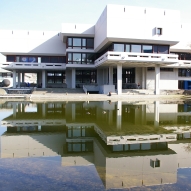Zusammenfassung
We report on microsecond-resolved in-situ SAXS experiments of the early nucleation and growth behavior of both cadmium sulfide (CdS) quantum dots in aqueous solution including the temperature dependence and of gold (Au) nanoparticles. A novel free-jet setup was developped to access reaction times as early as 20 mu s. As the signal in particular in the beginning of the reaction is weak the ...
Zusammenfassung
We report on microsecond-resolved in-situ SAXS experiments of the early nucleation and growth behavior of both cadmium sulfide (CdS) quantum dots in aqueous solution including the temperature dependence and of gold (Au) nanoparticles. A novel free-jet setup was developped to access reaction times as early as 20 mu s. As the signal in particular in the beginning of the reaction is weak the containment-free nature of this sample environment prooved crucial. The SAXS data reveal a two-step pathway with a surprising stability of a structurally relaxed cluster with a diameter of about 2 nm. While these develop rapidly by ionic assembly, a further slower growth is attributed to cluster attachment. WAXS diffraction confirms, that the particles at this early stage are not yet crystalline. This growth mode is confirmed for a temperature range from 25 degrees C to 45 degrees C. An energy barrier for the diffusion of primary clusters in water of 0.60 eV was experimentally observed in agreement with molecular simulations. To access reaction times beyond 100 ms, a stopped-drop setup -again contaiment-free is introduced. SAXS experiments on the growth of Au nanoparticles on an extended time scale provide a much slower growth with one population only. Further, the influence of ionizing X-ray radiation on the Au particle fromation and growth is discussed.




 Altmetric
Altmetric